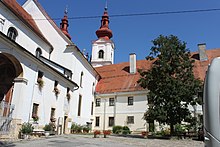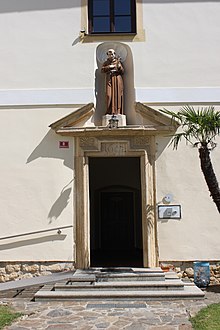Church and monastery of Sveta Trojica
Church and monastery Sveta Trojica is a pilgrimage church and monastery in the municipality of Sveta Trojica v Slovenskih goricah (German: Holy Trinity in the Windische Büheln ), in the Štajerska region in Slovenia . The church is the dominant building and the namesake of the place.
Sveta Trojica Church
history
In 1631 a wooden pilgrimage chapel is mentioned for the first time, which stood on the hill on which the church and monastery now stand; he was called Purgstalberg . According to legend, pilgrims saw three bright lights or stars of great brightness on the hill. According to the story, this miracle led to a first chapel in honor of the Holy Trinity. Count Wolfgang von Stubenberger was captured and imprisoned by agents of the Doge in the 17th century because of a love affair. In the event of his release, he vowed to found a monastery in his homeland. An Augustinian monk helped him to escape and out of gratitude and to fulfill his vows he founded the Holy Trinity Monastery.
The new church, the cornerstone of which was laid by the Seckau bishop Johann IV. Markus von Altringen on June 15, 1636, was built until 1640 on the site of a small wooden chapel from 1631, of which nothing has survived. The new building was necessary because the pilgrimages increased more and more. From the first brick building from the 17th century only a bell tower, part of the main nave and the main altar and a bell from 1666 (cast by Peter Zwölfer in Graz) remain.
In addition to the Stubenbergers, Siegmund Friedrich Graf von Trauttmannsdorff in particular campaigned for the construction and made sure that the Augustinians came to the Holy Trinity.
As the flow of pilgrims continued to increase, the Augustinian order decided to expand the church. For the construction of the church, Pope Innocent XII. issued a special indulgence in May 1693; also from his successor Pope Clement XI. in February and May 1702. During these years 12,000 to 16,000 pilgrims came to Holy Trinity. Holy Trinity became the most popular place of pilgrimage in Lower Styria. Construction work finally began in 1735, but often had to be interrupted for lack of money. Only with a large donation from Count Josip Kazimir Drašković von Trakošćan could the high altar be consecrated as early as Easter 1756, the complete construction work was not finished until 1780. The new church was twice as long as the previous building, the nave was raised to 14 m and widened with two aisles. The interior of the church has been rotated from the original east-west direction to a north-south direction. The old nave became the presbytery and the bell tower, which was now above the high altar due to the redesign of the nave, was rebuilt in 1772. Two new towers were built between 1779 and 1780 in the north at the main entrance. These three towers also served as a symbol of the Trinity of God. On October 13, 1781, under Emperor Joseph II , pilgrimages were prohibited due to the Josephine reforms and by means of the Edict of Tolerance . With the end of the pilgrimages, there were major financial losses. The eight competent priests were withdrawn and from April 15, 1786, the monastery church became its own parish, which was occupied by the diocese of Lavant . In 1796, a hurricane damaged the central bell tower and tore off its roof. It was not renewed until 1885. In order to be able to better preserve the church and the monastery buildings, in 1828 the community applied to the Marburg bishop Ignaz Franz Zimmermann to transfer the parish and monastery to the Franciscan order. Bishop Anton Martin Slomšek complied with this request on June 11, 1853 and on July 23, 1854 the Franciscans took over the parish and monastery. After the various prohibitions of the Edict of Tolerance were lifted, pilgrimages to the Holy Trinity began again. However, since only two priests were assigned for it, it never achieved the importance it had in the 18th century. In order to stabilize the church slope, today's two-winged staircase to the church was built in 1855. In 1933 the exterior was renovated.
Architecture and equipment
It is a typical Austrian baroque church, as it can often be found in Styria. The interior is dominated by a large nave on 12 columns, which is fourteen meters high. The two-part rows of benches create a line of sight from the main entrance to the high altar.
The main altar dates from 1756 and is set back a little. It was created between 1752 and 1756 under Joseph Straub, who also created the altar figures, and contains one of the largest altarpieces in Slovenia. It shows the portrait Mystery of the Trinity by K. Schmidt. The following legend is about the altarpiece, which Count Wolfgang von Stubenberg commissioned at Mureck Castle around 1640: The Lutheran painter recognized in his finished painting that it was not he, but God's hand who had created this portrait and converted to the Catholic faith. The work is framed by two columns, angels and allegorical figures. On the sides of the main altar are the four most important saints of the Augustinian Order: St. Augustine , Thomas von Villanova , Nicholas of Tolentino and St. John of San Facundo. The number of side altars is unusual: on each side there are three, to the left of the main altar for Mary the Sorrowful , Thomas of Villanova, Nicholas of Tolentino with Saint Roch of Montpellier ; on the right adoration of the Holy Cross , Sankt Augustin and Sankt Florian . They were completed by 1759. The ceiling frescos and the frescoes in the presbytery are the work of the Italian artists Giacomo Brollo and the brothers Oswald and Egidius Bieri. They were created in 1884. Since 2003, one of the largest organs in Slovenia with 53 registers has been located in the gallery above the entrance.
Loreto chapel
In 1693, a Loreto chapel was added to the north side of the church as thanks for the end of the Turkish invasions. It was donated by Maria Elisabeth Trauttmannsdorff Countess von Negau. Pope Innocent XII. granted the faithful a full indulgence when visiting the chapel on the Assumption of Mary . It contains a statue of the Black Madonna and Child on a column, also from 1693. On Mary's holidays, the statue was carried in procession through the village. The chapel was painted with frescoes between 1883 and 1884 by Giacomo Brollo and the brothers Osvaldo and Egidius Bieri.
Trinity Chapel
The Trinity Chapel (Slovenian trioglata kapela ) stands on the site that was originally intended for the building of the church. It is the place where, according to legend, the three lights were seen in the sky that marked the beginning of the pilgrimages. Since the location was not suitable for a large church, it was built about 50 meters further away. The chapel was built in the 17th century; an exact year of construction is not known. It was built with a triangular floor plan to symbolically commemorate the main church and the Holy Trinity.
The chapel contains small altars in honor of the Holy Trinity, Saint Isidor and Saint Leonhard , who is the local patron. The chapel was originally decorated with frescoes, which are almost no longer there. At the end of the 19th century the chapel was so dilapidated that it could no longer be used due to the risk of collapse. In 1904 it was extensively renovated and consecrated by the Bishop of Marburg, Mihael Napotnik, along with a new way of the cross .
Sveta Trojica Monastery
The monastery is just east of the church and is still run by the Franciscans to this day.
history
The monastery complex was built between 1665 and 1692 and was not originally connected to the church. The Counts of Trauttmannsdorff provided the funds for this. The Augustinians, who had run the parish since 1663, moved into the building. During the construction of the new church until 1780, the east wing of the monastery was extended so that it is adjacent to the church and you can go into the church from the monastery. The sacristy on the east side became part of the monastery building. The monastery was not directly affected by the Edict of Tolerance of Emperor Joseph II. It was not closed because it housed a school; so the monastery was not considered "unproductive" and was allowed to stay. However, since pilgrimages and begging were forbidden, the financial basis of the monastery was lost and in 1787 the order applied for the monastery to be closed, which was carried out in October 1787 under the district governor Count Anton Colloredo . The last Augustinian monk to look after the parish left the monastery in 1811.
The monastery was partially empty until 1887 and served, among other things, as a stable and warehouse. Over the years it deteriorated more and more. The Franciscan Order, which had led the parish since July 1854, wanted to take over the monastery and demolish the buildings. The community then agreed to renovate the monastery so that the monks could move in in 1888 and live there to this day. A museum is now housed in parts of the building. The monastery offers overnight accommodation for pilgrims on the Via Savaria, the historic pilgrimage route from Steinamanger to Tours , a cultural route of the Council of Europe .
architecture
The complex consists of a two-story building, divided into a south wing with sixteen windows and an east wing with eleven windows. In 1740, as part of the construction of the new church, the east wing was enlarged by two rows of windows so that the building is directly adjacent to the church. The sacristy of the Holy Trinity was integrated into the building. The courtyard with a fountain from the founding time was rebuilt in 1739 and given a monument to St. Augustine. The renovation of 1888 is still recognizable today by the different wall structure.
Monastery library
The monastery library was laid out in 1692. Almost all of the books were taken away when the Augustinians moved out in 1787. The Franciscans brought their books with them from 1854, mainly from the former Franciscan monastery Rann in Lower Styria (today: Brežice). In 1888 the library was rebuilt to its present appearance. In total, the library has over three thousand books from before the 19th century. The oldest books date from the 16th century. The most valuable exhibit is the oldest printed physics book from 1574. The library is open to the public.
Photo gallery
Web links
- Website of the municipality (Slovenian)
Individual evidence
- ↑ Jelena Obradović: Nemški geografska imena na področju slovenske Štajerske (German: German place names in the Slovenian Styria); P. 53; Maribor, 2010
- ↑ Non-profit and exhilarating house calendar for the Austrian Empire ... by Joseph Ritter von Seyfried, Vienna 1841
- ↑ http://rkd.situla.org ; Ministry of Culture of Slovenia; Register of Immovable Cultural Heritage, No. ešd 3464
- ↑ Information boards of the Sveta Trojika monastery
- ↑ http://rkd.situla.org ; Ministry of Culture of Slovenia; Register of Immovable Cultural Heritage, No. ešd 7117
- ↑ http://rkd.situla.org ; Ministry of Culture of Slovenia; Register of Immovable Cultural Heritage, No. ešd 13400
Coordinates: 46 ° 34 ′ 32 " N , 15 ° 52 ′ 37" E
















